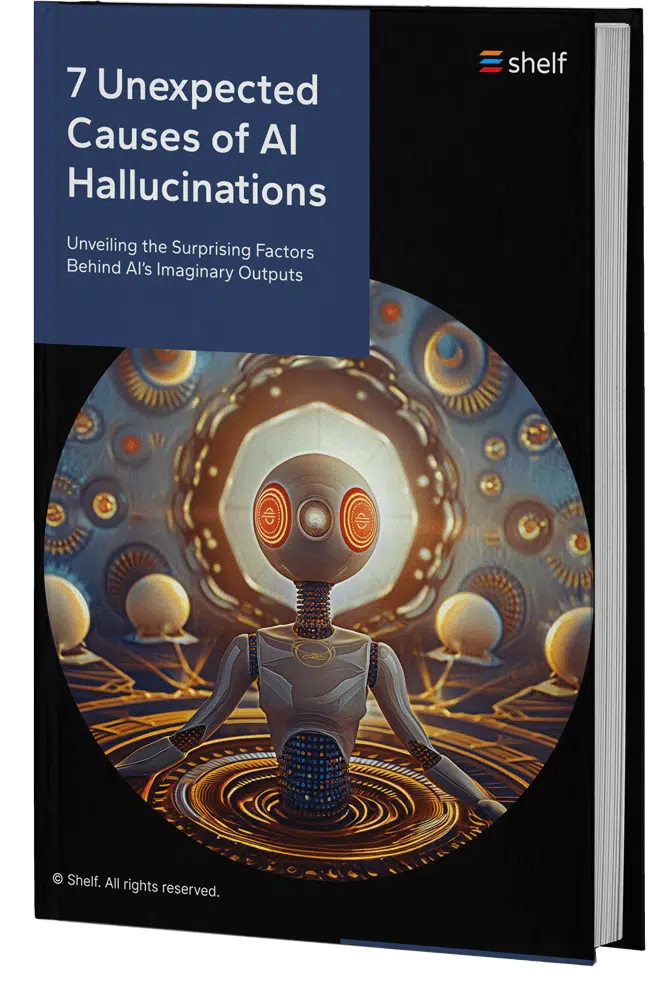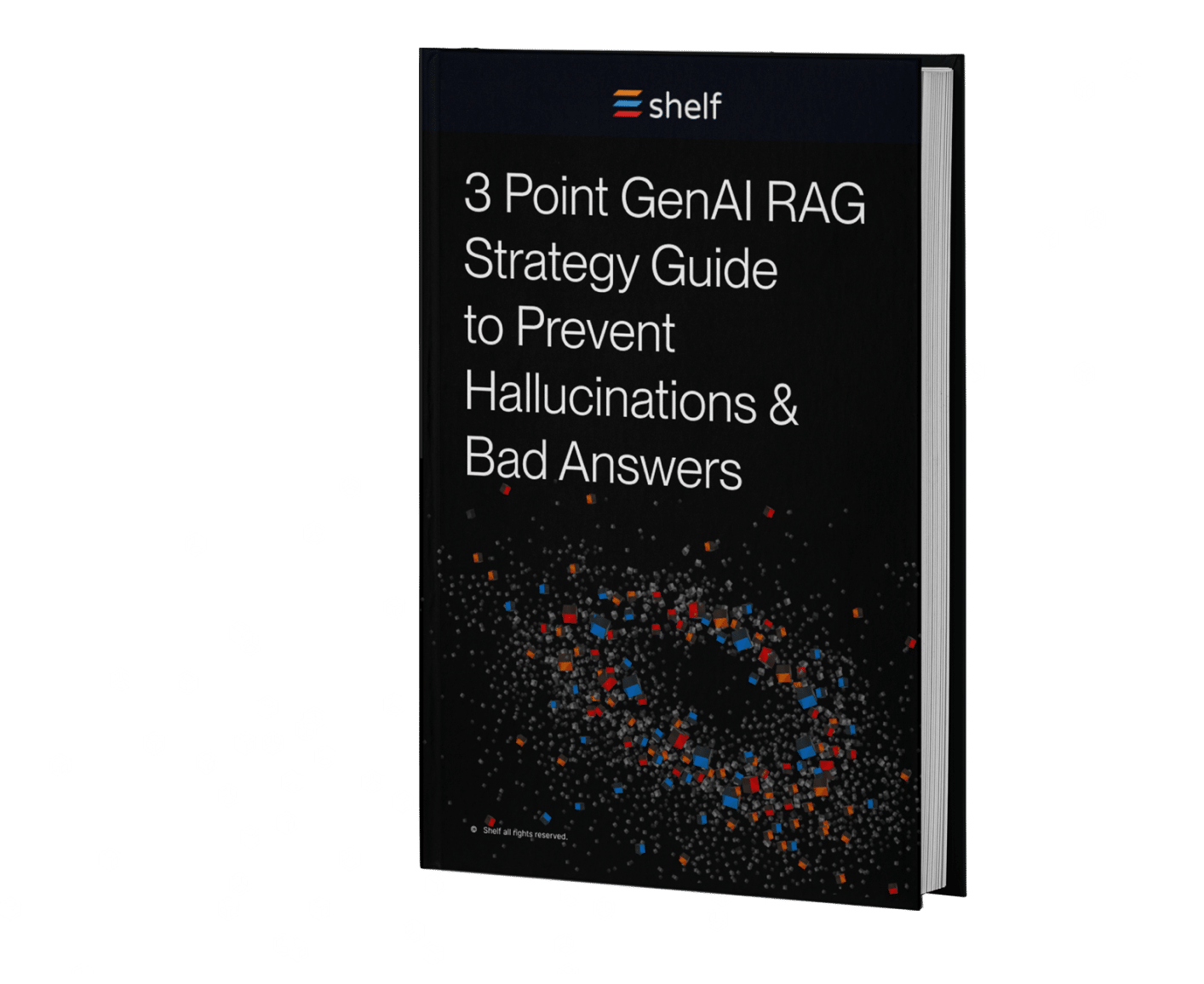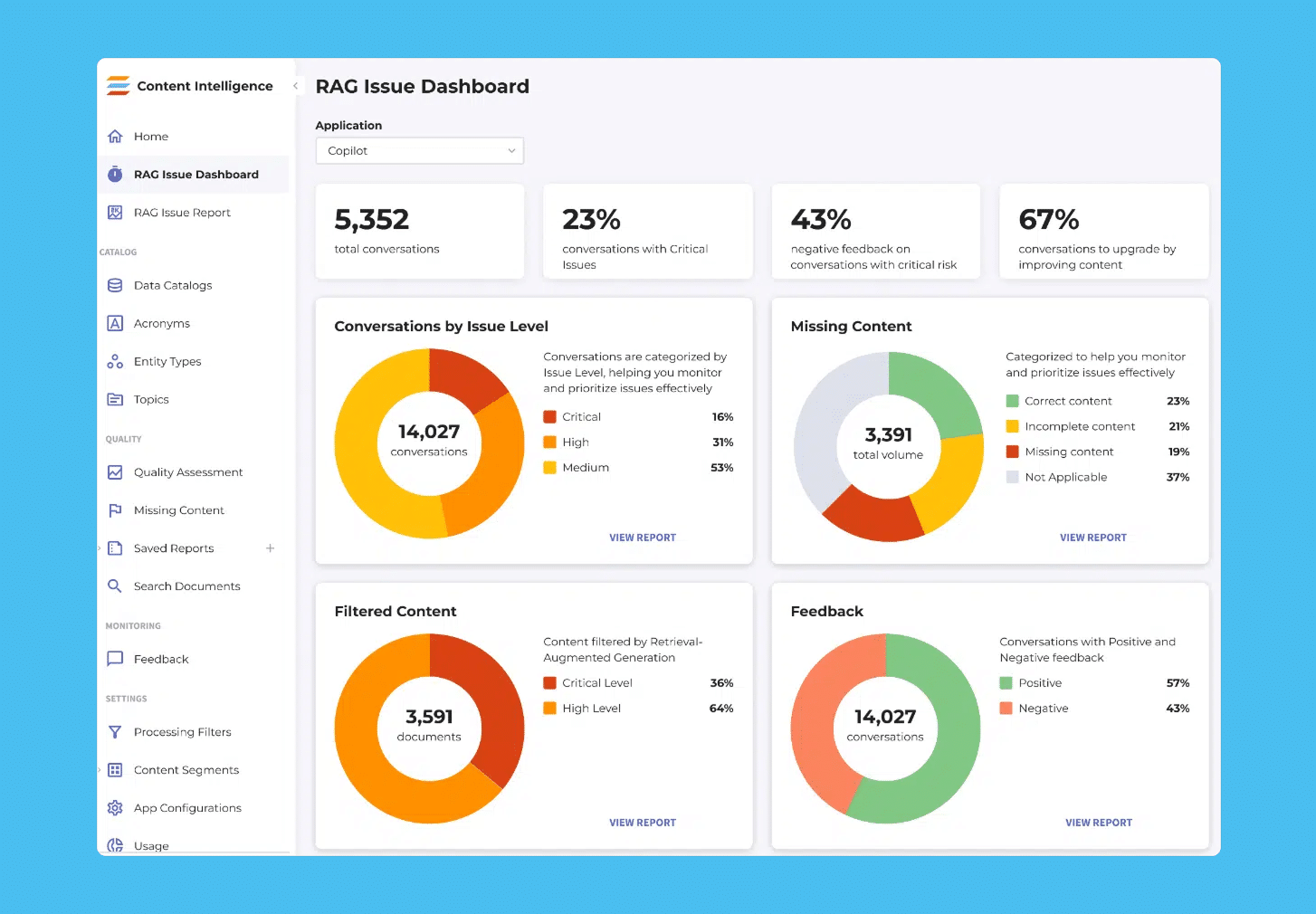AI for predictive analytics represents a cutting-edge approach to forecasting future trends and making data-driven decisions. With the help of AI, you can uncover deep insights, identify emerging opportunities, and even mitigate potential risks.
In this article, you’ll learn how AI for predictive analytics is transforming various sectors and how to use it in your organization.
What is AI-Powered Predictive Analytics?
AI predictive analytics uses machine learning (ML) algorithms and models that learn from data over time. These models are trained on historical data so they can identify patterns and relationships.
Once trained, the models are applied to new, unseen data to make predictions about future outcomes. This is not about crystal-gazing but about making informed estimations based on solid data-backed insights.
Artificial intelligence in predictive analytics transforms raw data into actionable intelligence. For instance, by analyzing past customer behavior, a predictive model can forecast future buying patterns. Similarly, in healthcare, AI-powered models can predict patient outcomes, assisting healthcare providers in crafting preemptive treatment plans.

Key Components of AI Predictive Analytics
AI predictive analytics is not a monolith but a symphony of various components working together to deliver insights that are deep and actionable. There are three core components: Data, Algorithms, and Predictions. Each plays a crucial role in transforming raw information into predictive insights.
Data
Data is the bedrock of AI predictive analytics. Without data, even the most advanced AI models are like engines without fuel. This data can come in various forms: structured data like numbers and categories, or unstructured data like text and images. (See our comparison of structured vs. unstructured data.)
For predictive analytics to be effective, the data must be comprehensive, accurate, and relevant. It undergoes various processes, including cleaning (removing inaccuracies or inconsistencies) and preprocessing (transforming data into a format that algorithms can work with).
Algorithms
Algorithms are the brains of AI predictive analytics. They are the complex mathematical models that learn from data to make predictions. These algorithms can range from simple linear regression models to complex deep learning networks, depending on the complexity of the task and the nature of the data.
Machine learning algorithms adjust their parameters based on the patterns they detect in the data, continually improving their predictions over time. The choice of algorithm is important as it directly impacts the accuracy of the predictive insights.
Predictions
Predictions are the actionable insights derived from analyzing and interpreting the data through the chosen algorithms. Predictions can take various forms, from forecasting future trends, classifying data points, or identifying potential anomalies.
The value of these predictions lies in their accuracy and relevance, as they can help you make informed decisions, anticipate future trends, or identify opportunities and risks.
How Predictive Analytics and AI Work
Predictive analytics and AI create a dynamic system that forecasts future events with remarkable acuity. This system involves a series of steps that transform raw data into predictive insights. Here’s a breakdown of how this integration works.
1. Data Collection and Preparation
Vast amounts of varied data are gathered. This data can be sales figures, customer interactions, sensor data, or anything else. The preparation phase is equally crucial, involving cleaning (to remove errors or inconsistencies) and preprocessing (to format and structure the data).
2. Model Building and Training
Once the data is ready, the next step is to build a predictive model. This is where AI, particularly machine learning, plays a pivotal role. During the training phase, the model is fed historical data so it can learn and identify patterns, trends, and relationships within the data. The choice of algorithm impacts the model’s ability to learn from data, with options ranging from simple linear regression to more complex neural networks.
3. Validation and Testing
After training the model, it’s crucial to test its accuracy and effectiveness. This is done by using a separate dataset, not seen by the model during training, to evaluate its performance. Validation assesses how well the model can generalize its learning to new, unseen data.
4. Deployment and Real-time Predictions
Once validated, the model is deployed into a production environment where it can start making real-time predictions. For instance, a predictive model in a retail setting might analyze real-time sales data to forecast future demand, enabling the business to adjust its inventory accordingly.
5. Continuous Learning and Improvement
AI-driven predictive models aren’t static. They’re designed to learn and adapt. As new data becomes available, the model can be retrained or fine-tuned, enhancing its predictive accuracy. This continuous learning is fundamental to AI, ensuring that the predictive analytics process remains relevant and accurate as conditions change.

Benefits and Challenges of AI-Based Predictive Analytics
AI-based predictive analytics is a powerful tool that offers a multitude of benefits but also presents certain challenges. Understanding these can help you navigate and leverage this technology more effectively.
Benefits of AI-Based Predictive Analytics
- Enhanced Decision-Making: With AI-driven insights, you can make more informed decisions, reducing guesswork and enhancing strategic planning.
- Increased Efficiency: AI algorithms can analyze vast datasets much faster than human analysts, leading to increased efficiency in operations.
- Proactive Risk Management: AI predictive analytics can identify potential risks and issues before they escalate so you can take proactive measures. This can be especially valuable in industries like finance or healthcare.
- Personalization Opportunities: In sectors like retail or e-commerce, AI predictive analytics help you personalize offerings, tailoring products, services, and marketing to individual customer preferences.
- Future Trend Prediction: Beyond immediate insights, AI predictive analytics can forecast long-term trends, such as market trends or customer behavior.
Challenges of AI-Based Predictive Analytics
- Data Quality and Quantity: The accuracy of AI predictions is reliant on the quality and quantity of data. Inadequate or poor-quality data can lead to inaccurate predictions.
- Model Complexity and Interpretability: Some AI models can be complex and opaque, making it challenging to understand how they arrive at certain predictions.
- Ethical and Privacy Concerns: Ensuring that predictive analytics complies with regulations and ethical standards is crucial to maintaining trust and integrity.
- Integration and Implementation: Integrating AI-based predictive analytics into existing systems and workflows can be challenging, especially for organizations without a robust IT infrastructure or with legacy systems that are not conducive to modern AI solutions.
- Skill Gap: There’s a significant skill gap in the market, with a high demand for professionals who can interpret AI predictive analytics.
Predictive Analytics Techniques
Predictive analytics comes with a toolbox full of techniques, each tailored to different types of data and goals. Understanding these methods helps you choose the right one for the task at hand. Here’s a breakdown of the most common techniques you’ll likely encounter.
Regression Analysis
Linear regression is one of the most basic and widely used predictive analytics techniques. It’s used to predict a continuous outcome variable based on predictor variables. The relationship between the input and output is assumed to be linear.
On the other hand, logistic regression is good for binary classification tasks, such as predicting whether an event will occur or not (yes/no, true/false). It calculates the probability of a particular outcome.
Time Series Analysis
Time series analysis is used when data is sequential over time and the goal is to predict future values based on past trends and patterns. It’s helpful in economics, finance, and any field where data is collected over time.
Decision Trees
Decision trees are a type of model used for classification and regression. They split the data into branches based on decision points over the input features, creating a tree-like model of decisions and their possible consequences.
Random Forests
An extension of decision trees, random forests combine multiple decision trees to improve predictive accuracy and control over-fitting. Each tree in the forest is built from a sample drawn with replacement from the training set. The final prediction is made by averaging the predictions of the individual trees.

Neural Networks and Deep Learning
Neural networks are inspired by the structure and function of the human brain. Deep learning, a subset of machine learning, involves neural networks with many layers. These techniques are particularly effective for complex tasks like image recognition, natural language processing, and time series forecasting.
Clustering
While not predictive in the traditional sense, clustering is a useful technique in exploratory data analysis to identify distinct groups or patterns in data. It’s often a preliminary step in predictive analysis to understand the underlying structure of the data.
Ensemble Methods
Ensemble methods combine multiple predictive models to improve accuracy. For example, boosting and bagging are two approaches where multiple models are trained to solve the same problem and their predictions are combined to produce a final result.
Support Vector Machines (SVM)
SVMs are a set of supervised learning methods used for classification, regression, and outlier detection. They are effective in high dimensional spaces and cases where the number of dimensions exceeds the number of samples.
Uses and Examples of Predictive Analytics
Predictive analytics is a versatile technology that’s useful in countless industries and sectors. It’s used to enhance decision-making, optimize processes, and predict future trends. Here are some uses and examples that illustrate the breadth of predictive analytics applications:
1. Retail
Inventory: Predictive analytics helps retailers forecast demand for products so they can optimize their inventory levels, reduce holding costs, and minimize stock outs or overstock situations.
Personalized Marketing: By analyzing customer behavior, purchase history, and preferences, you can predict what products a customer is likely to buy next. This allows you to personalize marketing strategies and product recommendations.
2. Finance
Credit Scoring: Financial institutions use predictive analytics to assess a customer’s creditworthiness, predict the likelihood of loan default, and determine credit limits based on historical financial behavior.
Fraud Detection: Predictive models analyze transaction patterns to identify unusual behavior indicative of fraud. Financial institutions can set proactive measures to prevent financial loss.
3. Healthcare
Patient Risk Assessment: Hospitals use predictive analytics to identify patients at risk of developing certain conditions. This allows for early intervention and improved patient outcomes.
Treatment Personalization: By analyzing patient data, healthcare providers can predict which treatments will be most effective for specific individuals. This leads to personalized care plans.
4. Manufacturing
Predictive Maintenance: Manufacturers use predictive analytics to forecast when machinery is likely to fail or require maintenance. Ultimately, this can minimize downtime and extend equipment lifespan.
Supply Chain Optimization: Predictive models can forecast supply chain disruptions, which helps adjust their logistics and production strategies proactively.
5. Telecommunications
Churn Prediction: Telecom companies analyze customer data to predict which customers are at risk of churning. Then they use targeted retention strategies to save accounts.
Network Optimization: Predictive analytics can forecast network usage and identify potential bottlenecks, helping you optimize network performance and improve service quality.
6. E-commerce
Dynamic Pricing: E-commerce platforms use predictive analytics to adjust prices in real-time based on demand, competition, and customer behavior.
Customer Lifetime Value Prediction: Predictive models help you forecast the potential value of customers. This helps you guide marketing and customer relationship strategies.
7. Transportation and Logistics
Route Optimization: Predictive analytics can forecast traffic conditions. Logistics use this information to optimize delivery routes and reduce fuel consumption.
Demand Forecasting: Transportation companies use predictive models to anticipate passenger or cargo volumes, adjusting schedules and capacity accordingly.
Predictive Analytics Tools
In order to implement predictive analytics, you’ll need an analytics platform with tools to generate the right insights. These tools vary in complexity and functionality, so choosing the right one depends on your specific needs, technical expertise, and the scale of your projects.
- IBM SPSS – A user-friendly tool for statistical analysis and predictive modeling, ideal for both beginners and advanced analysts.
- SAS Advanced Analytics – A comprehensive suite offering tools for data mining, machine learning, and predictive modeling in enterprise environments.
- RapidMiner – An end-to-end platform for data preparation, machine learning, and deployment, designed for ease of use with no coding required.
- Tableau – Primarily a data visualization tool, Tableau integrates predictive capabilities to help you identify trends and forecast future outcomes.
- Microsoft Azure Machine Learning – A cloud-based platform offering tools for building, deploying, and managing machine learning models, scalable for enterprise use.
- Google Cloud AI Platform – Provides a robust suite of machine learning and predictive analytics tools, leveraging Google’s advanced AI capabilities.
- KNIME – An open-source analytics platform with drag-and-drop functionality for data preparation, analysis, and machine learning.
- Alteryx – A no-code/low-code platform for data analytics, featuring built-in predictive analytics tools and seamless data preparation workflows.
- H2O.ai – An open-source platform offering AI and machine learning capabilities, focused on speed and scalability for predictive tasks.
- TIBCO Statistica – A tool designed for advanced analytics and data science, with a focus on enterprise-friendly integration and ease of use.

How to Get Started with AI Predictive Analytics
Implementing AI for predictive analytics can be a game-changer for your business or organization, but getting started can be overwhelming. Here’s a structured approach to get started with AI predictive analytics:
1. Define Your Goals and Objectives
Understand what you aim to solve or achieve with predictive analytics. Is it about improving customer retention, forecasting sales, optimizing operations, or something else? Having a clear problem statement is crucial.
Then establish what success looks like. Define specific, measurable outcomes that you want to achieve through predictive analytics.
2. Assemble Your Team
Ensure you have the right mix of skills on your team, including data scientists, data engineers, business analysts, and IT specialists. If your existing team lacks certain skills, consider training them or collaborating with external experts.
3. Data Collection and Preparation
Collect data that is relevant to your goals. This could include historical data, real-time data streams, external datasets, etc. Data quality is vital here. Cleanse your data to remove errors or inconsistencies, and preprocess it (e.g., normalization, handling missing values) to make it suitable for modeling.
4. Select Tools and Technologies
Decide on the tools and platforms you’ll use, based on your team’s expertise and your specific needs. This could range from Python or R for custom model development to user-friendly platforms like Tableau for data visualization. Consider whether to use cloud-based analytics services or on-premise solutions, depending on your data security requirements, budget, and scalability needs.
5. Develop and Train Predictive Models
Choose appropriate predictive modeling techniques (e.g., regression, decision trees, neural networks) based on the nature of your problem and the data. Train your models using a subset of your data and validate their performance using another subset. The goal here is to make sure that your model is accurate and can generalize well to new data.
6. Deploy and Integrate the Model
Once satisfied with a model’s performance, deploy it into a production environment where it can start generating predictions from new data. Automate the input of new data into your model and make the predictions available to end-users or downstream systems.
Next, embed your predictive model into your business processes. This might mean integrating it into your CRM system for sales forecasting, your inventory management system for stock optimization, or your customer service platform for anticipating customer inquiries.
Finally, ensure that stakeholders understand how to interpret and act on the model’s predictions. This may involve training sessions or the development of user-friendly dashboards that present predictive insights in an understandable manner.
7. Monitor and Refine Model
Predictive models are not set-and-forget solutions. They should be continually refined and improved based on new data and changing conditions. Regularly retrain your model with fresh data to ensure it remains relevant and accurate.
Fine tune the model by experimenting with different model configurations, feature selections, and tuning parameters. This process, known as hyperparameter optimization, can significantly impact the effectiveness of your predictive models.
You should also establish a feedback mechanism to capture the performance of your model in real-world applications. Use this feedback to identify areas for improvement and to refine your model accordingly.
8. Act on Insights
Make sure that the model’s predictions are interpretable and actionable. Stakeholders should understand what the predictions mean for the business. Use the insights gained from your predictive analytics to inform business decisions, strategies, and processes.
9. Ensure Ethical Compliance
Be mindful of the ethical implications of your predictive models, particularly in terms of privacy, bias, and transparency. Ensure that your predictive analytics complies with all relevant regulations and industry standards.
Embrace AI for Predictive Analytics
By embracing AI-powered predictive analytics, you can unlock new levels of efficiency, accuracy, and foresight. This helps you stay ahead of your competitors and better serve your customers.



